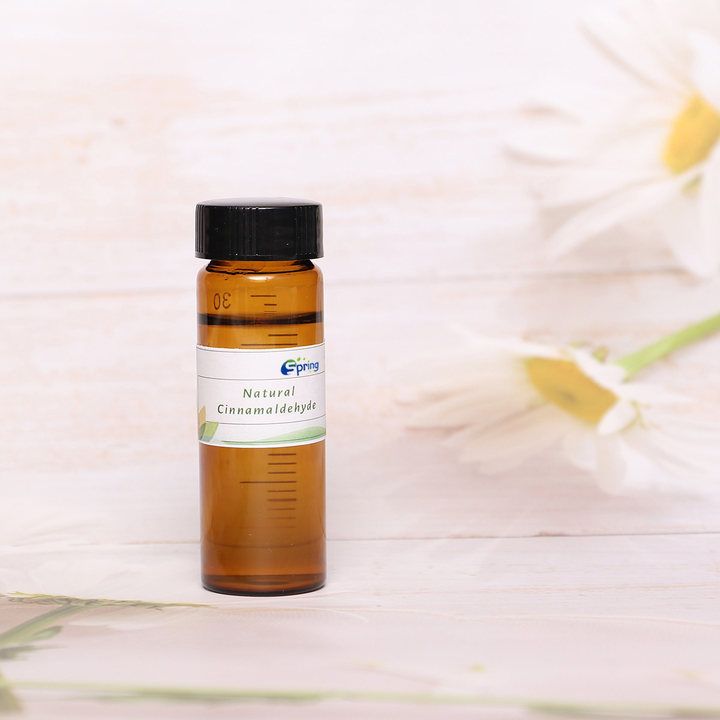Financial News
Antibacterial application of cinnamaldehyde in food packaging
Cinnamaldehyde accounts for 85% ~ 90% of cinnamon essential oil, and China is one of the main planting areas of cinnamon, and cinnamaldehyde resources are rich. Cinnamaldehyde (C9H8O) molecular structure is a phenyl group connected to an acrylein, in the natural state of yellowish or yellowish brown viscous liquid, with a unique and strong cinnamon and coke flavor, can be used in spices and condiments. At present, there have been a lot of reports on the broad-spectrum antibacterial action of cinnamaldehyde and its mechanism, and the studies have shown that cinnamaldehyde has a good antibacterial effect on bacteria and fungi. In the field of medicine, some studies have reviewed the research progress of cinnamaldehyde in metabolic diseases, circulatory system diseases, anti-tumor and other aspects, and found that cinnamaldehyde has a good anti-diabetes, anti-obesity, anti-tumor and other pharmacological activities. Because of its rich sources, natural ingredients, safety, low toxicity, unique flavor and broad-spectrum antibacterial effect, it is a food additive approved by the United States Food and Drug Administration and China. Although the maximum amount is not limited in use, its volatility and pungent odor limit its wide application in food. Fixing cinnamaldehyde in food packaging film can improve its antibacterial efficiency and reduce its sensory impact on food, and play a role in improving the quality of food storage and transportation and extending the shelf life.
1. Antibacterial composite membrane matrix
Most of the research on antibacterial packaging film of food uses natural and degradable substances as the film-forming matrix, and the packaging film is prepared by coating, casting or high temperature extrusion method. Due to the different mode of action and compatibility between different membrane substrates and active substances, the properties of the finished membrane are different, so it is very important to select the appropriate membrane substrate. Commonly used film-forming substrates include synthetic biodegradable substances such as polyvinyl alcohol and polypropylene, natural substances such as polysaccharides and proteins, and composite substances. Polyvinyl alcohol (PVA) is a linear polymer, which usually forms a three-dimensional network structure when crosslinked, and has excellent mechanical properties and barrier properties. Natural membrane-like matrix resources are abundant and widely sourced. For example, polylactic acid can be fermented from raw materials such as starch and corn, which has sufficient and renewable sources, good biodegradability and biocompatibility, and is an ideal environment-friendly packaging material. The composite matrix is often composed of two or more membrane matrices, which can play a complementary role compared with a single membrane matrix.
Mechanical properties and barrier properties are important indicators to evaluate the suitability of packaging film. The addition of cinnamaldehyde will cross-link with the polymer membrane matrix and thus reduce the molecular fluidity, the decrease of elongation at break is due to the discontinuity of polysaccharide network structure, and the increase of tensile strength is due to the increase of hydrophilic group during the film forming process caused by the addition of cinnamaldehyde. In addition, the gas permeability of cinnamaldehyde composite membrane was generally increased, which may be due to the dispersion of cinnamaldehyde into the polymer to create pores, voids and channels, reduce the mass transfer resistance of water molecules, and ultimately lead to the increase of the gas permeability of cinnamaldehyde composite membrane. The mechanical properties and permeability of several composite membranes are similar, but the structure and properties of different polymer substrates are different, and the different interactions with cinnamaldehyde will affect the performance of the packaging film, and then affect its application, so it is very important to select the appropriate polymer substrate and concentration.
Second, cinnamaldehyde and packaging film binding method
However, cinnamaldehyde is slightly soluble in water with a solubility of only 1.4 mg/mL. Although the blending technology is simple and convenient, the two phases of the fat-soluble cinnamaldehyde and water-soluble membrane matrix are unstable, and the high temperature and high pressure conditions usually required in the film forming process significantly reduce the concentration of available cinnamaldehyde in the membrane. It is difficult to achieve the ideal bacteriostatic effect. Embedding technology is the process of using the wall material to wrap or adsorb the active substance that needs to be embedded to provide performance support or chemical protection. The use of embedding technology to fix cinnamaldehyde in the packaging material can make its slow release, improve the retention rate, extend the antibacterial aging of the film, and optimize the mechanical properties of the packaging film. At present, the common carrier construction methods of combining cinnamaldehyde with packaging film can be divided into two categories: artificial carrier construction and natural carrier construction, including polymer embedding, nano liposome embedding, cyclodextrin embedding, nano clay binding or loading. Through the combination of layer self-assembly and electrospinning, the cinnamaldehyde delivery carrier can be optimized, and the action mode and application range of cinnamaldehyde can be improved.
Application of cinnamon aldehyde active food packaging film
Different types of food have different water content, nutrient composition and storage and transportation conditions, and the growth dynamics of spoilage microorganisms are very different. The preservation effect of cinnamaldehyde antibacterial packaging for different foods is also different.
1. Fresh-keeping effect on vegetables and fruits
China is rich in natural resources, among which the production and market consumption of vegetables and fruits are huge. However, the moisture and sugar content of vegetables and fruits are high, rich in nutrition, and are prone to microbial pollution and deterioration during storage, transportation and sales. At present, the application of antibacterial packaging film is an important means to improve the storage and transportation quality of vegetables and fruits and extend their shelf life. The cinnamaldehyde-polylactic acid composite film packaging of apples can reduce the loss of nutrients, inhibit the growth of rhizopus, and extend the storage period of apples to 16 days. When cinnamaldehyde active food packaging film was applied to fresh-cut carrot packaging, the growth of mold and yeast was inhibited, the rot rate of vegetables was reduced, and the shelf life was extended to 12d.
2. Fresh-keeping effect of meat products Meat foods are rich in protein, fat and other substances, rich in nutrition and unique taste. At room temperature, the reproduction of microorganisms causes the decomposition of meat proteins, carbohydrates and fats, resulting in meat corruption, sticky surface, dark color, loss of elasticity, and unpleasant odor. Cinnamaldehyde active food packaging film is widely used in pork and fish packaging, mainly inhibits the growth of Staphylococcus aureus, Escherichia coli, aeromonas, yeast, lactic acid bacteria and other bacteria, and can extend the shelf life of 8 ~ 14d.
3. Fresh-keeping effect of dairy products At present, the consumption of dairy products in China is increasing year by year. Cheese is a fermented milk product with rich nutritional value and protein. But cheese has a short shelf life, and the waste rate at low temperatures is still alarming. The use of cinnamic aldehyde food packaging film can effectively extend the shelf life of cheese, ensure good taste of cheese, and prevent cheese rancid deterioration. For cheese slices and cheese sauces, the shelf life is extended to 45 days and 26 days respectively after using cinnamaldehyde active packaging, which is conducive to saving resources.
4. Fresh-keeping effect of starch food bread and cake are starch products, made of wheat flour processing, soft pine cotton, sweet and delicious. However, bread and cake have a short shelf life and are susceptible to mold contamination during sales, resulting in quality degradation and food waste. The use of cinnamaldehyde active food packaging in sponge cake and sliced bread can inhibit the growth and propagation of penicillium and black mold, and extend the shelf life to 10 ~ 27d, respectively.
Cinnamaldehyde has the advantages of abundant source, high bacteriostasis and low toxicity. As a bacteriostasis agent in food active packaging, the stability and slow release of cinnamaldehyde can be improved by constructing and optimizing the delivery carrier, which is of great significance for improving the storage and transportation quality of fresh food and extending the shelf life of food. In recent years, cinnamaldehyde has made many achievements and progress in the research of food packaging preservation, but the related application research is still in the initial stage, and there are still some problems to be solved. Through comparative study of the effects of different delivery carriers on the mechanical properties and barrier properties of the membrane, in-depth exploration of the mode of action of cinnamaldehyde and carrier and its release kinetics in different environments, study of the influence of the growth law of microorganisms in food on food spoilage, and the regulatory mechanism of antibacterial packaging on the timing and release speed of antimicrobial agents. Design and develop active packaging systems that can meet different food preservation requirements.


Media Contact
Company Name: Suzhou Springchem International Co., Ltd.
Email: Send Email
Phone: +86-512-57593213
Country: China
Website: https://www.sprchemical.com/
More News
View More




Recent Quotes
View MoreQuotes delayed at least 20 minutes.
By accessing this page, you agree to the Privacy Policy and Terms Of Service.



